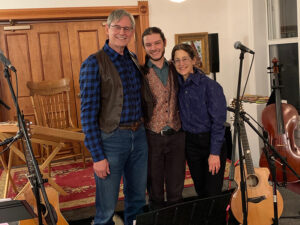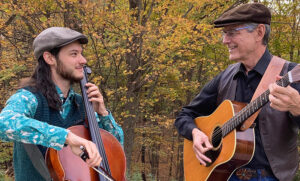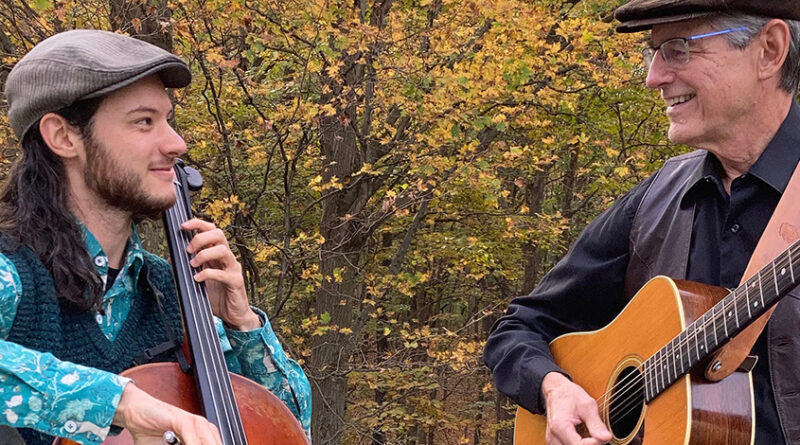Bruce Ward: In Tune with Architecture, Music
Hamilton resident splits his time presiding over the Earlville Opera House and his own architectural firm
By Aaron Gifford

As a teenager, college student and then a young professional just starting out, Bruce Ward often found himself torn between the guitar and T-square.
Now, as a Hamilton resident and craftsman who lives and works in the same community where he finished school, the architect by day and musician by night and weekends blends both instruments into perfect harmony.
“I feel pretty fortunate,” said Ward, who owns Bruce Ward Architect A.I.A. “I got my foot in the door for both passions.”
Ward, 69, recently talked about his upbringing, love for music and vocational interests to include his leadership of the historically famous Earlville Opera House and his continued desire to serve the small Madison County community.
Ward grew up in Candor, a town south of Ithaca in Tioga County. He began singing in his church choir at the age of 5. He also played clarinet in the school band. He rode his bike as often as he could and later enjoyed driving tractors and old cars on his grandfather’s dairy farm. He came from a family of tinkerers. He fondly recalls watching his dad, an engineer, create designs of heating, ventilation and air conditioning systems.
In eighth grade, Ward worked part-time for his father, earning $1 an hour filing documents and running errands. This experience prompted Ward to take a mechanical drawing class in high school, inspiring strong interest in the work architects who outsourced engineering tasks to his father.
“As soon as I saw what they did,” he said, “I thought those architectural drawings were a lot cooler than what the engineers drew.”
With his savings from the job, Ward bought a guitar at 16 and learned to play folk songs by Gordon Lightfoot and Peter, Paul and Mary.
After high school graduation, Ward enrolled at Colgate University. His initial course of study included liberal arts classes with a heavy mix of math and science for a path to engineering, but Ward found himself spending far more time in the music department. He changed his major to music and sang in the nationally acclaimed Colgate 13 a cappella group.
With guitar and bachelor’s degree in hand, Ward set out to make a living at folk music. The solo artist had a few gigs at local restaurants, but that career was short-lived. He was living in Ithaca at the time with his first wife. He tried his hand at drawing again and in 1977 was hired by the Fred Thomas Associates architecture firm. Ward worked there on and off for a few years between attempts as a long-term substitute music teacher in Southern Tier school districts, but a career in teaching wasn’t meant to be.
“Yes, some of the kids could be difficult, especially if they really didn’t want to be in music class,” Ward said. “I don’t think they [schools] wanted me to come back for another year.”
Ward returned to design drawing as his main gig, and eventually obtained architect certification. He got divorced and re-married, moving to Hamilton with his new wife, Sarah, who obtained a teaching job at Colgate. They lived in walking distance to the school because Sarah didn’t have a driver’s license at the time.
“And Hamilton is where we stayed,” Ward said.

Ward worked for architecture firms in Sherburne and Manlius before eventually going into business for himself in 2002. With previous employers, Ward had worked on public school projects, mobile home parks and multi-family dwellings, but he always preferred drawing up designs for custom single-family homes, so he stuck with that passion.
“I still enjoy my job,” he said. “I really can’t see retiring from it any time soon.”
Ward said his trade has evolved dramatically in the past four decades. The pencils and T-squares made way for computer three-dimensional designs. The ways materials are applied, and the types of materials used have changed. Concrete, for example, is frowned upon because of contributions to greenhouse gasses.
“Educating the client is such a big part of the job now,” Ward explained. “Just the way homes are heating and cooled — that has come such a long way. Everything now is about sustainability.”
Music has remained Ward’s deepest passion. He volunteered with the Earlville Opera House just outside of Hamilton in the 1990s and became the organization’s president in 2015. Ward oversees facility projects as well as event planning for the 300-seat venue. He called those tasks, “a labor of love.”
“A ton of work goes into it,” Ward said. “But we’ve preserved an intimate venue where the sound is great, and performers can hobnob with the audience.”
The Earlville Opera House is a New York State Landmark and is listed in the National Register of Historic Places. The site, located near the border of Madison and Chenango counties, has existed since 1892. The current structure was built in 1895 (the first two there were destroyed by fire).
According to its website, the opera house featured live entertainment from 1895 until 1922 to include Vaudeville acts, low-budget operas and traveling medicine shows. It was converted into a silent movie house early in the 20th century and occasionally took on the role of public auditorium to include high school graduations, political caucuses and town meetings.
The Earlville Opera House remained closed during the Great Depression, re-opening as a move theatre in 1937. It closed again in the early 1950s, unable to compete with larger theatres, drive-in movie venues and television. It reopened in the early 1970s as a volunteer-based organization and has remained afloat since then. In recent years, the opera house has been a popular venue for singer–songwriters acts, often of folk or mixed genre types.
Ward himself has sung at the Earlville Opera House, though he stressed that the paid performers are more established artists who go on tour. Ward loves to strum his guitar and sing folk songs at home without an audience, but he also performs with the Syracuse Vocal Ensemble, a jazz group that plays in four programs annually and rehearses once a week between September and May.
When he is not drawing or playing music, Ward enjoys riding a bike as often as possible. His longest trek to date was about 100 miles. This was a group ride that followed a route from Stockbridge, to Oneida, to the Erie Canal Towpath through Canastota and Chittenango and DeWitt and then back.
Ward usually prefers to peddle close to Hamilton, where he volunteers with the Community Bikes program. The organization refurbishes hundreds of bikes annually and provides them to families throughout eastern Madison County. In addition, as part of the “In Tandem” initiative with Community Bikes, Ward and other volunteers ride tandems with disabled persons served by the Heritage Farms program. The volunteer “captains” steer and peddle the two-person bikes from the front. The “stokers” sit at the back of the bike and can also peddle if they are able. The tandems ride around the village of Hamilton.
“It’s a lot of fun,” Ward said. “It’s just one of many great things going on in Hamilton. It’s a lifestyle that I enjoy.”
Ward’s son resides in Boston and his daughter lives in Denver. He has three grandchildren. In addition to visiting family, Ward and Sarah enjoy working out at the Colgate fitness center and frequent the Hamilton Farmers’ Market for local produce. They try to prepare vegetarian meals at least twice a week.
“We try to eat healthy without being fanatics,” Ward said. “I do like a steak once in a while.”
Ward advises never to give up one passion to pursue another, whether a vocations or the arts, and always be willing to look for new opportunities.
“To love what you do at work, after work and for volunteer work for the community — I’m grateful for that,” Ward said.

